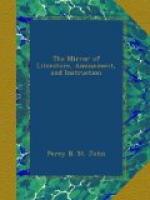The Mexican population is commonly divided into seven classes:—1. European Spaniards, commonly called “gachupines.” 2. White Creoles. 3. Mestizos, descendants of Whites and Indians. 4. Mulattoes, descendants of Whites and Blacks. 5. Zambos, from Indians and Negroes. 6. Pure Indians. 7. African Blacks. But this classification may be reduced to four:—1. Whites. 2. Indians. 3. Blacks. 4. Mixed Races, the various gradations of which may be considered almost infinite.
The Indians consist of a considerable number of distinct tribes, differing in many points of appearance, and speaking—not dialects but—languages entirely different. No less than twenty of these have been traced, and of fourteen of them there are already grammars and dictionaries. The Indian population is chiefly centered in the great plains, and towards the south; and Humboldt thinks that it has flowed from the north to the south. The history of four great migrations is preserved in the annals of Mexico, which are worthy of more detailed examination than we can bestow upon them. The great body of these people live apart from the other races of their countrymen, in small villages, full of ignorance, suspicion, and bigotry, and displaying an apparent phlegm, from which it would seem impossible to arouse them. This phlegmatic temperament lessens the credit of the men with the females, who uniformly prefer the European, or the still more vivacious negro. “The indigenous Mexican is grave, melancholic, silent, so long as he is not under the influence of intoxicating liquors. This gravity is peculiarly remarkable in Indian children, who at the age of four or five years display more intelligence and precocity than the children of whites. The Mexican loves to attach mystery even to his most trifling actions; the strongest passions do not display themselves in his countenance; the transition is frightful when it passes suddenly from a state of absolute repose to that of violent and unrestrained agitation.” Slavery with them has engendered guile. They are obstinate in all their habits and opinions; their religion is one of mere ceremonial, justifying the observation of a priest to Mr. Ward, “son mui buenos Catolicos, pero mui malos Cristianos” (very good Catholics, but very bad Christians.) Deception in this, as well as in every thing else, is the order of the day; and the Indian Alcalde now oppresses the villagers as much as he himself has ever been.
Humboldt considers the Mexican Indian as destitute of all imagination, though when to a certain degree educated, he attributes to him facility in learning, a clearness of understanding, a natural turn for reasoning, and a particular aptitude to subtilize and seize trifling distinctions.
The music and dancing are as dull as might be expected among beings so full of phlegm. The Mexican has a turn for painting and sculpture; and retains the same fondness for flowers that struck Cortez so forcibly upwards of three centuries ago. The “Indios Bravos,” or Wild Indians, are said to display more energy; but our information respecting them is remarkably scanty.




